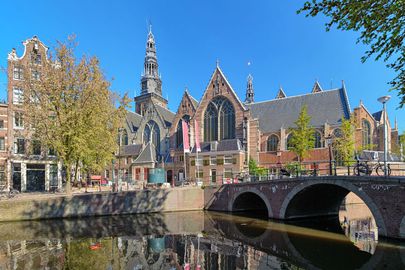

The oldest building and the oldest parish church in Amsterdam majestically rises above De Wallen, one of the world’s largest red-light districts and certainly its most famous. One would think it least likely that a red-light district should surround a religious temple of such scale and grandeur. Yet the connection has existed for centuries, the red-light district having been located around this area since the Middle Ages. And the sailors whose ships anchored in the Amsterdam harbor during the Golden Age would pay a visit to the prostitutes before being absolved of their sins at the Old Church.
The church was founded around 1213 and was consecrated by the bishop of Utrecht with Saint Nicholas as its patron saint. The Oude Kerk is the only remaining church in Amsterdam that was built as, and until the Reformation acted as, a Catholic church. During the Reformation, statues were removed, frescoes painted over, ceremonial silver stolen or melted down, and the Catholics driven to hold their services in clandestine churches such as Our Lord in the Attic [2]. In addition to religious purposes, the church also fulfilled secular ones. Fishermen repaired their sails and nets here and it acted as a meeting point for citizens and merchants, where they could exchange thoughts or wander around while the organist played. In the Middle Ages, these activities earned the Oude Kerk a nickname of ‘Amsterdam’s Living Room.’
Over 10,000 Amsterdam citizens were buried under the flagstones of the Old Church. Hundreds of gravestones with names chiseled in stone remain to this day, including that of Saskia van Uylenburgh, Rembrandt’s beloved wife; J.P. Sweelinck, the famous organist and composer, and Jacob van Heemskerck, a famous Dutch seafarer and explorer who saved the crew of Barentz’s polar expedition which got lost while trying to discover the northern passage.
These days the church is a favorable venue for weddings, exhibitions and concerts. Weddings have taken place here since the Middle Ages. The following piece of advice is written above the Red Door, which the couples about to get married have been going through since 1580: 'Tishaestgetroutdatlange rout', which means ‘Hasty marriage leads to long suffering'. The door contains a small peephole window called 'judas', through which curious onlookers could spy on the couple.
The square surrounding the Old Church, called Oudekerksplein, originally acted as a graveyard. In 1655 the graveyard was cleared and moved to a new location beyond the city walls, and the present square was created. Around the back of the Oude Kerk there are some 35 windows from behind which prostitutes offer their services. As part of the so-called Project 1012 introduced in 2007, the Amsterdam city council has already reduced the number of prostitutes’ working windows around Oudekerksplein by about a third. By 2030 the municipality intends to remove all brothels from the square and replace them with restaurants, boutiques and arts and crafts galleries. The coffeeshop located on the Oudekerksplein would also be closed in accordance with this plan. The square features two artworks. A sculpture entitled Belle represents a prostitute in a window frame and honors the sex workers of the world. It was placed there in 2007. The plaque on this statue reads, "Respect sex workers all over the world". About 10 meters to the east, among the cobblestones, you will find a bronze relief of a hand caressing a female breast. This sculpture was placed among the cobblestones by an anonymous artist in February 1993.